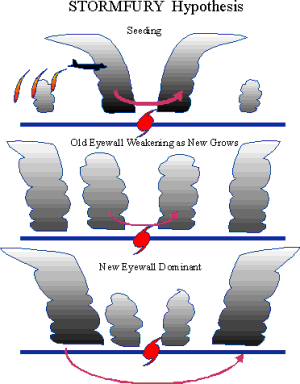 Project STORMFURY was an ambitious experimental program of research on hurricane modification carried out between 1962 and 1983. The proposed modification technique involved artificial stimulation of convection outside the eyewall through seeding with silver iodide. The invigorated convection, it was argued, would compete with the original eyewall, lead to reformation of the eyewall at larger radius, and thus, through partial conservation of angular momentum, produce a decrease in the strongest winds. Since a hurricane's destructive potential increases rapidly as its strongest winds become stronger, a reduction as small as 10% would have been worthwhile. Modification was attempted in four hurricanes on eight different days. On four of these days, the winds decreased by between 10 and 30%, The lack of response on the other days was interpreted to be the result of faulty execution of the seeding or of poorly selected subjects. These promising results came into question in the mid-1980s because observations in unmodified hurricanes indicated:
ReferenceWilloughby, H. E., D. P. Jorgensen, R. A. Black, and S. L. Rosenthal, 1985: Project STORMFURY, A Scientific Chronicle, 1962-1983, Bull. Amer. Meteor. Soc., 66, 505-514.Return to History page. Return to Modification page. Return to Mission Statement. |
About HRD
Links of Interest
AOML Tools & Resources
Employee Tools
|
